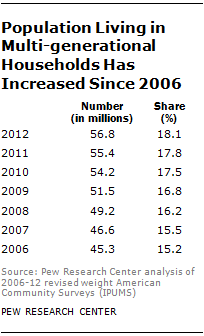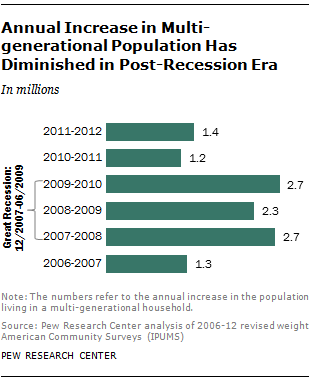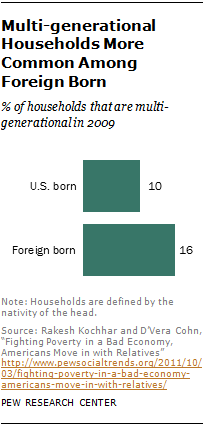 The growing number of Americans living in multi-generational households reflects more than the overall increase in the U.S. population. From 2009 to 2012, the number of people living in multi-generational households increased from 51.5 million to 56.8 million. Over that same time period, the share of the population living in multi-generational households rose from 16.8% to 18.1%.
The growing number of Americans living in multi-generational households reflects more than the overall increase in the U.S. population. From 2009 to 2012, the number of people living in multi-generational households increased from 51.5 million to 56.8 million. Over that same time period, the share of the population living in multi-generational households rose from 16.8% to 18.1%.
From 2007 to 2010, the multi-generational population grew substantially—swelling by well over 2 million people per year. Since 2010, the multi-generational population has increased at a slower rate—roughly 1 million per year.
 However, the Great Recession and its aftermath only accelerated an increase in multi-generational living arrangements that had been unfolding for several decades. In 1980, a post-World War II low of 12.1% of the population resided in a multi-generational household. By 2007, 15.5% of the population lived in a multi-generational household.
However, the Great Recession and its aftermath only accelerated an increase in multi-generational living arrangements that had been unfolding for several decades. In 1980, a post-World War II low of 12.1% of the population resided in a multi-generational household. By 2007, 15.5% of the population lived in a multi-generational household.
Looking back further in time, the modern rise in multi-generational households was a reversal of a previous trend. Throughout most of the 20th century intergenerational coresidence was declining. This downward trend was particularly sharp among the elderly. In 1900, 57% of adults ages 65 and older lived in a multi-generational household. By 1980, only 17% lived with multiple generations of family.
A number of factors likely contributed to the decreased tendency for the elderly to live with adult children early in the century. Marked improvements in the health of the elderly diminished infirmity and boosted their capacity to live independently. Rising incomes and the establishment of Social Security and private pensions greatly increased the financial well-being of older adults, enabling the elderly to afford privacy and independent living (McGarry and Schoeni, 2000).
 In addition to rising affluence, demographic factors played a role. Fertility declined substantially during the 1900s, reducing the number of children with whom elderly parents could potentially reside (Schoeni, 1998). And economic opportunities, with the transformation of the economy from an agrarian to an industrial basis, led many adult children to leave the family home and seek opportunities in the emerging labor market (Ruggles, 2007).
In addition to rising affluence, demographic factors played a role. Fertility declined substantially during the 1900s, reducing the number of children with whom elderly parents could potentially reside (Schoeni, 1998). And economic opportunities, with the transformation of the economy from an agrarian to an industrial basis, led many adult children to leave the family home and seek opportunities in the emerging labor market (Ruggles, 2007).
Since immigrants are more likely than U.S.-born Americans to live with multiple generations in the home, there is little doubt that some of the growth in multi-generational living is due to the third great wave of immigration that commenced with the passage of the Immigration and Nationality Act of 1965. Since 1980, the share of households headed by an immigrant has doubled (from 7% to 14% in 2012). In 2009, 16% of households headed by an immigrant were multi-generational, compared with 10% of households with a U.S.-born head.


